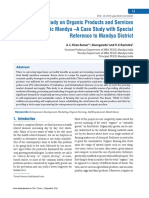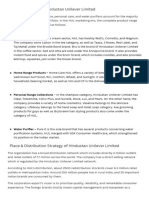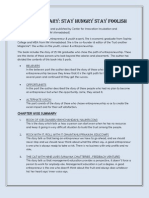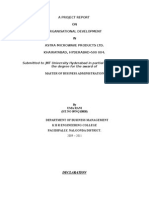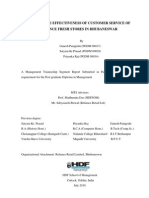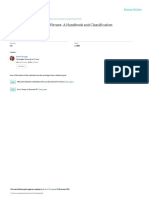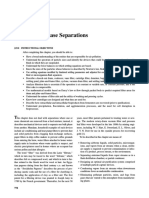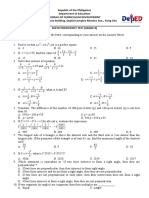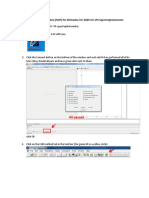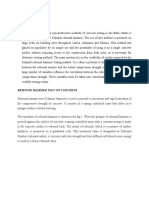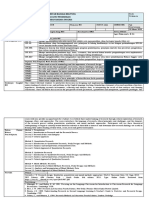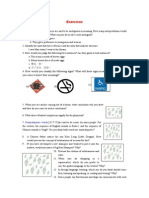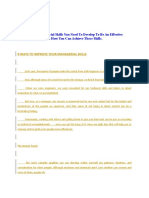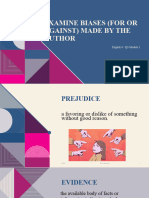Leadership Rahul Bajaj
Leadership Rahul Bajaj
Uploaded by
chiraglakhaniCopyright:
Available Formats
Leadership Rahul Bajaj
Leadership Rahul Bajaj
Uploaded by
chiraglakhaniCopyright
Available Formats
Share this document
Did you find this document useful?
Is this content inappropriate?
Copyright:
Available Formats
Leadership Rahul Bajaj
Leadership Rahul Bajaj
Uploaded by
chiraglakhaniCopyright:
Available Formats
Leadership, Leadership Role Models
Page 1 of 20
LEADERSHIP, LEADERSHIP ROLE MODELS CONCEPT QUESTIONS:
Give examples of born leaders and made leaders. Born leader are the ones who have inborn qualities of an leader. Where else in case of made leader it is often an mentor who shapes a leader. Examples of such leader are given below: Born leader: Dhirubhai Ambani, JRD Tata, Bal Thackeray Made leader: K.M.Birla, Anil Ambani, Ratan Tata, I.K.Gujral, The difference is only of degree and no one can be identified as being completely born leader or made leader. Management Styles A management style is a distinctive way in which Planning, Organising, Actuating, Controlling and other management functions are performed. Given the many choices in the performance of each management function, an almost limitless number of management styles can be visualized. In reality, however one encounters far fewer styles. This is because styles tend to be internally coherent. If a management chooses to coordinate activities participatively, it is also likely to set goals, develop strategies, control operations, etc. participatively rather than in an authoritarian manner. Styles tend to crystallize around major management convictions and commitments. That is, their cores tend to be ideological in character, and commitment to a core management ideology- of risk-taking in business or conservatism, professionalism in hiring staff or intuitive choices, and so on- is likely to shape the rest of the style. These commitments are not randomly generated. Nor are they exclusively the commitments of the person who happens to be the CEO, although undoubtedly the CEO usually does play a significant role in the evolution of a style of management. The style evolved has to be viable, that is it has to be able to measure up to real-life situations. A good deal of learning from experience plays a major part in the styles emergence. Social processes within the ranks of management, such as information and experience sharing,
Leadership, Leadership Role Models
Page 2 of 20
advocacy of points of view, political deals and so forth, also play a part. The purpose for which the organisation is set up and the social, legal and economic environment, in which it operates, too contribute to the viability of the style of management. Good and Bad styles of Management Human beings are an interesting species; they often talk about lofty ideals and perfection but practice quite the opposite. Determined by the super-ego and identity, human behavior may be repulsive or sublime. Hence the style of management adopted is an expression of the thoughts in the mind of the decision makers and leaders. Depending upon these thoughts the style could be good or bad. i.e. socially desirable or undesirable. In society, good styles are referred as professional and participative. If there is variety in excellence, there is variety in incompetence. The corporate sickness and dysfunctional forms of bureaucracy and professional management have uncovered a large number of bad forms of management. Describe the role of Karta in a Hindu Undivided Family: Karta is the head of a Hindu Undivided Family more commonly known as an HUF. The Karta of an HUF is the supreme authority in business matters. He is the leader of this organization. The other members of the family i.e. the co-parceners are not allowed to have their say in the matters relating to the organization. It is usually the Head of the family who is named the Karta. DESCRIPTIVE QUESTIONS Q 1) Critically analyze the leadership style and its central characteristic of the Indian leading industrialist: Rahul Bajaj , Dhirubhai Ambani, Mr. N.R Narayan
Murthy and J.R.D.Tata Rahul Bajaj
Rahul Bajaj is the man who can be given credit for building Bajaj auto are the 4 th largest two-wheeler manufacturer in the world. He has achieved an incredible growth rate of
Leadership, Leadership Role Models
Page 3 of 20
1852% in the last decade. Following are some of the points that explain the reason of his success.
Education: Bajaj is a highly educated person. He has done his BA (Hons) and is a management graduate from Harward. Concentration of Core Competency: Rahul Bajaj collaborated with Kawasaki for production of motorcycle but for scooter he did not go for any collaboration. Manufacturing scooters is his core competency and he does not want to experiment with that.
Customer is King: Bajaj has often been accused of exploiting the customers with delivery period of 10 years, black marketing, etc. but this is not true at the face value. A deeper insight brings to picture that there were other elements who are responsible for these accuses. Bajaj, in spite of a heavy demand, did not raise the price of his scooters and avoided exploitation of customers.
Staunch believer in himself: Bajaj listens to each and everyone, but takes decision on his own. His organisation is a little centralized. In spite of strong oppositions, he sticks to his decisions.
Never give up attitude: Licence Raj was a nightmare for Bajaj. He does not believe in bringing Government officials and getting his license cleared. This is a major reason why Bajaj Auto came under MRTP and was allowed to expand its production capacity. But he did not give up to the Government conditions and after some years, done lobbying through business housed and putting tremendous pressure on Government learn his license.
Jach Welchs theory: Rahul Bajaj holds same views of Mr. Jack Welch, the former CEO of GE. He believes that if one is no No 1 or No 2, he should get out from that business. This principle kept him away from the four-wheeler market.
Attitude towards workers: Bajaj has less kind of words for workers. Still, there has been only one strike in the history of 35 years of the company. He takes care of the needs of the workers and at the same time, he views workers as a tool for production. In his word Why do they strike and lose wages? They should work more, earn more
Leadership, Leadership Role Models
Page 4 of 20
BBC: Rahul Bajaj is well known for his unflinching frankness and varied opinion on every topic under the sun. His office is therefore popularly known as BBC (Bajaj Broadcasting Corporation)
Straightforwardness: His quotes about the Governnment have found place in the headlines of many leading newspapers and magazines in India and have also raised controversies. But this does not stop him from doing what he considers correct.
All the above features are the hallmark of Bajaj. They has earned him a rare reputation as one of Indias most successful industrialists. Squeaky clean, he has never been involved in shady takeovers. He does not engage in street fights, nor has he ever hijacked someone elses project. He hasnt burnt tyres during hard drive for meteoric growth. On the contrary, he is something of a plodder, routinely burning the midnight oil, and devoted to the virtues of hard work. Hes Indias most admired industrialist along with Dhirubhai Ambani and the late Adity Birla.
Dhirubhai Ambani
When we talk about Indian leaders one name, which we cannot miss out, is Dhirubhai Ambani. He has voyaged through a journey of rags to riches. He was born on 28th December 1932 to a local schoolteacher in a village called Chorwad, in Junagadh district, Gujarat. Dhirubhai has been an opportunist right from his childhood. All he needed was the whiff of a business opportunity and he was off to tap it. During the Mahashivratri fair, he would sell ganthia a gujaratri savoury to earn money. Due to shortage of money, he left education after matriculation and went to Aden to earn money. He worked for almost eight years in a petrol station where he learned about oil business until a day came when he was bitten by the entrepreneurial bug. He came back to Bombay to start his own business. He took a loan with which he started Reliance Commercial Corporation, which has been a stepping-stone to one of Indias largest Corporation. They were involved in general merchandising.
Leadership, Leadership Role Models
Page 5 of 20
Dhirubhai has always shown all the critical leadership qualities. He would always grab an opportunity and strike on it. He then started his yarn business in the 60s and then he build his own spinning mill in 1966 known as Reliance Textile industries. He believed that if a person wants to succeed in something then he should have complete access to information on that topic. Whenever he wanted to approach the government to get licenses, information about the competitors, market size etc. he would collect all these information, no matter at what cost it came. He also believes in destiny and gives all the credit to his luck. This shows how down to earth he is. Even today he has a simple ritual of Puja when a new machine is installed. He isnt proud of what he is and he still believes in Simple thinking, Modern thinking. He always followed the rule to be the pioneer/first to do anything. He would just grab an opportunity that would come up because of some government policy changes and would implement it successfully. He believed not in meeting demand but in creating demand. He always produced in large quantities. He was of the opinion that customer should be provided with best quality goods at the lowest price. Moreover Dhirubhai as opposed to most other leaders wasnt expert in only one field. He was a manufacturing as well a marketing whiz. He knew how to offer the right product mix, identify markets and establish viable distribution structure, which holds true for one of his famous brand Vimal. He is also referred to as Manchester of India. He didnt mind copying someone elses idea, which he could implement better than his competitors. As in the case of copying the concept of selling through showrooms for his brand Vimal to counter the resistance from the traditional markets which he copied from Bombay Dyeing. He always had the dynamism and confidence in future and was always ready to go against all odds. He always believed in himself. He has always believed that his first responsibility is towards his companys shareholders and he was also concerned in protecting their interests. He also known as the stock market messiah. This is because when some Marwari clan were trying to bring down the price of
Leadership, Leadership Role Models
Page 6 of 20
his shares by short selling, he counter attacked them and in turn earned a hefty sum from them. He has always had a wide investor base and most of his subscriptions were over subscribed. He has always been an innovator in the financial market. He innovated and reintroduced successfully concepts like partial convertible bonds, fully convertible bonds etc. He has been successful in manufacturing world-class products. He always believed in Think big, think fast and think ahead. He has never had an ego problem and he knew how to get his work done from people. He was never ashamed to salaam anyone. Another incident that shows his vision as a leader is that when Reliances Patalganga Complex was damaged due to floods. Technical experts from Du Pont estimated hundred days to make the complex operational but Reliance had the complete complex operational in twenty-one days. This was possible because of Dhirubhais vision, his confidence, his dedication proper logistical planning and making available all resources. Dhirubhai has always believed in picking up the best talent. They have a motivated workforce. He only believes in providing leadership, vision and strategy. He thinks that he doesnt run his business but his business leaders do it. Dhirubhai is criticized for manipulating the government for his benefits. Apart from that he has paid zero tax on corporate earnings for several years due to the loopholes in the system. He was also involved in manipulating the L&T board to gain control. Apart from that he was heavily criticized along with Pranab Mukherjee for buying shares under dummy companies which never existed. But be it whatever Dhirubhai is one of the greatest leaders of India who has the zeal to achieve something big rather than just earning money and the obsession to build. He wants to work till his death. As a true leader Dhirubhai had once said that, People think I have finally arrived but I think I have just begun.
Leadership, Leadership Role Models
Page 7 of 20
Mr. N.R Narayan Murthy
Mr. Narayan Murthy was born in a middle class family in Siddalghat in Karnataka, His father inculcated importance of determination, discipline and good values. Since childhood he had a very good academic record. At present he is the Chairman of Infosys. Present market capitalization of Rs. 60,000 crores Infosys started with Rs.10, 000.Mr. Narayan Murthy is influenced by Mahatma Gandhi who walked his talk and demonstrated by, Example He says he wants to be a doer and respects people who do things, rather than just talk. Some of the traits that differentiates him from others are: His Underlying principle: Is that, you undertake to do something you are confident of and have the capability to do it. This helps to lay the foundation to build a healthy relationship. He also believes that it is better to have a small part of a large, growing pie; than a large part of small shrinking one. Simple living-high thinking: A man who believes in Simple living high thinking. Even though he has a personal wealth of Rs. 2,500 crores, his lifestyle remains modest. He lives in a simple 2-bed room flat in Santacruz-Mumbai. Under-promising & Over-delivering: He has tremendous respect for people and sound philosophy of under-promising & over delivering. This helps him build a healthy long-term relationship with his colleagues, employees, family, friends, business associates and network of shareholders. Pioneer in HRM: Mr. Murthy says that his is an HR-based industry. Software is a knowledge business hence the focus is shifted to Brainware. It was he who started ESOPs that is real distribution of wealth. Now it is very common in the industry to have ESOPs but it has
Leadership, Leadership Role Models
Page 8 of 20
done wonders in Infosys. Thus Narayan Murthy is honestly awe-inspiring role model for professionals. Performance Oriented: He is a man who always measures performance against value. According to Murthy peoples performance in the knowledge industry is as valuable as gold. Thus by introducing ESOPs he motivated his employees to work smart and hard.
Strategy: ( Customer is the King): Even though there is a lot of competition in the market he believes in one thing that is, being unique in the market place and making sure that you are the 1st mover. Tap the need of the customer and give them more than they expect. Believes in giving value to the customer, being fair to people and transparency in working. Mr. Murthy says that Growth comes from repeat business, repeat business comes from relationships, and relationships with customers are built on trust and trust is built by delivering quality products.
Social being: He believes in putting the public good ahead of private good in every decision he makes. This differentiates the developed world from the developing world. Infosys practices its Social responsibility very well. Rehabilitation drive, literacy programme, donations etc are few ways in which he works for the society.
Visionary: Though Infosys had so many professionals it did not venture into dotcom because of the vision of Mr. Narayan Murthy. This saved them from going down. The downfall of dotcoms has not affected his business much. Before starting Infosys this visionary got together with 6 professionals and wanted to start have Indias first software company of the professionals, for the professionals, by the professionals, and because of his farsightedness Infosys has come this far and proved to be a winner. Thus Narayan Murthy is honestly awe-inspiring role model for the professionals.
Leadership, Leadership Role Models
Page 9 of 20
JRD TATA
When talking about Indias greatest leaders, one name just cannot be skippedJ.R.D. TATA. For decades the sole Indian businessman, global leaders had ever heard of, was Tata. Its different todaythe Sunday Times, Forbes and even the hallowed Harvard Business Review now carries articles written by Indian mgt. gurus on Indian case studies. But for years the world passed India by. Only J.R.D. Tata made an impact. When J.R.D. became chairman of Tatas in 1938, British firms dominated the environment, but the House of Tata towered above all others. It had 14 companies with sales of Rs. 280 crores. The year he died, 1993, it was still Indias biggest business house. Sales had mushroomed to Rs. 15000 crores and there were over 50 large manufacturing companies besides innumerable holdings and concerns. He was a distinguished and respected industrialist who was also awarded the BHARAT RATNA, remarkable achievement. What sort of value system made the great man achieve his greatness? Following is an analysis of some of the virtues & vices, which J. R. D. displayed through the course of his eventful life: Virtues: J.R.D. was
Approachable: - J.R.D. had no problems making friends easily. He had one of the most comfortable personalities that was probably his benchmark of becoming a successful individual.
Diplomatic: - One of the most difficult talents is to say no in a nice manner. But Diplomacy was never a problem for J.R.D. Even when he was angry at Nehru for going against industrialists, he was never rude but made his point diplomatically and walked away friends.
Realistic: - J.R.D. never plunged into unviable projects, howsoever exciting they might be. He briefly flirted with the idea of making bombers with Tata Aircraftbut despite his love for flying, he shot down the project himself when it became clear that there was no money to be made.
Leadership, Leadership Role Models
Page 10 of 20
Charismatic: - When J.R.D. was elected chairman of the group, there was no question about the selection. There was no one else who could have been chosen by the board. J.R.D. by then was a hero. The daring pilot, the shrewd businessman. He was already outstanding.
Courageous: - J.R.D. had always supported Nehrus views on socialism. Something that the board of Tata sons did not agree with. But J.R.D. refused to sign the manifesto against socialism. It must have required considerable courage for a 30- something to stand up for views, which differed so widely from those of the old guard.
Compassionate: - People talk of Russi Mody but he manipulated people. J.R.D. genuinely felt for workers. His approach to labor was that of Fabian socialism. After J.R.D.s entry, the management of Tisco changed its policy of confrontation. The trade union became not only acceptable but also an association which was vital to the interests of the workers.
Supportive towards innovation: - Apart from his supportive attitude towards Tiscos lab technicians, perhaps Tata chemicals provides the best demonstration of J.R.D.s willingness to support innovation in his business and among his managers.
Aware of a sense of responsibility: - There were opportunities for J.R.D. where he was tempted to joined politics. But he rationalized to himself by concluding that he could do more for the country in business and industry than in politics. He says, I had no doubt that freedom was on its way. But who knows, I might one day have an opportunity to serve in more useful ways than by going to jail today!
Committed to values: - J.R.D. never believed in paying under the table for getting a license approved. He never believed in exploiting the workers, society and earning more profits. It was believed that wealth and respect are disjoint. J.R.D. was considered to be an exception to this rule.
A visionary: - J.R.D. was the only director on the board of the Tata group who supported Ratan Tatas plan to enter high investment high risk industries like oil manufacturing & computers. He believed, that being that stalwart business house of India, such investments were a responsibility.
Vices:
Leadership, Leadership Role Models
Page 11 of 20
J.R.D. was..
Conservative: - J.R.D. always preferred the more conservative approach. His conservativeness left Tisco unprepared for the outbreak of the second world war and the license-permit raj of free India.
Aloof: - Unlike G.D. Birla, J.R.D. had kept aloof from the congress leadership. For a group that depends as much as the Tatas did on government patronage, this was a major lacuna.
Bad tempered: - Instead of trying to patch up the differences, J.R.D. withdrew into himself. He rejected Nehrus invitations to the UN session in Paris, and the invitation to lead Indian Rare Earths, one of the first PSUs. J.R.D. forgot the Public Relations implications of these prestigious invitations and the signals his refusal emitted.
After going through the above virtues and vices of Indias greatest industrialist, we learn a lot about what it takes to be successful in business, career, and in ..life. Q 2) Critically analyze the differences in the leadership styles of a family managed Indian business organizations and MNCs in India? Ans. Family business is same like any other organization because essentially it is a venture for profit like any other MNCs. But the difference stems up because of the fact that family business is a fusion of business system and the family system this fusion is absent in other forms of organizations. This difference manifests itself in the style of leadership of an organization, which is given in detail below:
Variables under consideration Born vs made leader Role of a leader
Family managed Indian business organization More often then not, made leader Many a times deviates from policy formation, planning etc. and role is reduced to conflict manager engaged in solving clashes and reduces
Multi national corporations in India More of born leader Involved more in business issues and concentrates in formulating long term business plans. Keeps away from day to day operations.
Leadership, Leadership Role Models
Page 12 of 20
Funding strategy
Partnerships & strategic alliances Recruitment & remuneration policy
Profitability & empowerment
Strategic financial planning Decision making process
the role of leader to merely a mediator Conservative equity funding. Does not believe in participative funding. Domestic, local currency funds are preferred financers (mostly family friends or relatives) Family-relationships were more important than high value high return partnerships with outsiders. Low wages, high job security to the employees. Trusted persons are generally preferred to others who may be better qualified. As empowerment was limited, employees were (at the most) responsible for volumes & costs. Sharing of business results was missing. Inward-looking, conservative financial strategies are used for business growth.
Capital has no colour or quality. It has only cost & applicability. Hence, live and let live policy with global capital is welcome, with hedging arrangements. Do not bother for close linkages. Growth is welcome, from whatever sources available Higher wages with profitsharing but without job security. Recruitment is based on pure merits. Extreme of empowerment is possible i.e. an employee may be treated as a profit centre. Responsibility Accounting is predominantly used. Long term strategic plans are well-designed with greater clarity. Decentralized decision making. There is more delegation of authority Relationship is very professional and has empathy towards other. has its own advantages and
Control is tight and is achieved by posting relatives of owners or members of their community in decisionmaking process Leader member More of emotions based. relationship Leader holds sympathy for others because they are his own family members. No one style can be said to be the best. Each style grace of Indian family business style.
disadvantages. One cannot deny that, we need phase of multinational leadership style and
Leadership, Leadership Role Models
Page 13 of 20
Q 3) Depending upon the structure of task-high or low - analyse what impact will it have on leadership Ans: Task structure refers to the degree to which the task is clearly defined. A bank tellers job has relatively high task structure; the branch managers job has less. The nature of the situation, specifically the characteristic of the task affects the impact of the leaders behaviour on follower satisfaction and effort. Basically, the leader chooses among four styles:
1.
Directive. The leader tells employees what he expects of them, gives them guidance about what they should do, and shows them how to do it. Supportive. The leader shows concern for the well-being and needs of her employees by being friendly and approachable. Participative. The leader involves employees in decision making, consults with them about their views of the situation, asks for their suggestions, considers those suggestions in making a decision, and sometimes lets the employees make the decisions.
2.
3.
4.
Achievement oriented. The leader helps employees set goals, rewards the accomplishment of these goals, and encourages employees to assume responsibility for achieving the goals.
Situational characteristics Task Structured Unstructured Clear goals Ambiguous Directive No Yes No Yes
Leadership styles Supportive Yes No Yes No Achievement oriented Yes Yes No Yes Participative Yes No Yes No
goals When the task is structured; the supportive, achievement oriented and participative leadership styles are preferred. But the directive style of leadership is not preferable when the task is structured. This is because when the employees are aware of what the task they are supposed to finish there is no need for the employer to direct them.
Leadership, Leadership Role Models
Page 14 of 20
When the task is unstructured, the directive and achievement oriented styles are preferred rather than the supportive and participative style. This is because the employees are not fully aware of the task to be performed and therefore a leader who tells or helps employees to set goals would be more effective rather than a leader shows concern or involves employees. Consider the president of a new start-up company in which the ten employees are hand picked, the tasks are highly ambiguous, but the presidents authority is clear. A directive or achievement oriented style would work well. When the goals set are clear the leadership style that is preferred is supportive and participation. The only difference between a structured task and clear goals is that an achievement oriented leadership style is not preferred. This is because when the goals are already set, you dont require a leader who sets them and rewards them. The last case where the task has ambiguous goals, the leadership style to be adopted is similar to that of the unstructured task. This is because one would require a directive and achievement oriented leader to set goals, instruct the employees, guide them, reward them when the goals are ambiguous. Conclusion: there is no golden rule as to which leadership style to be adopted depending upon the task structure but the analysis given above would have a higher probability of success ratio so as to effectively lead. Q 4) Explain the conservative, entrepreneurial, professional, bureaucratic and organic styles of management. Along with the ten pure styles of management, a defective version of each pure style was also developed. The pure styles were developed on the basis of research done on management styles both in India and abroad, as well as extensive management consultancy and training experience. Similarly, the defective forms were conceptualized on the basis of research and consultancy and training experience.
Leadership, Leadership Role Models
Page 15 of 20
The ten pure management styles are the conservative style and the sharply contrasting entrepreneurial style, the professional style and contrary to it the intuitive style, the participative and the opposing authoritarian style, the organic or free form and the opposing bureaucratic style, the familial style or paternalistic style, and the altruistic style. Some of the important ones are enumerated below: a) The conservative style: The essence of conservatism is conservation of what has worked in the past and has demonstrated survival value. The principle of survival is at the core of the conservative style of management. Conservatism does not necessarily mean refusal to change. It means instead, caution in changing. The pure conservative style was defined as follows: A cautious one-step-at-a-time approach to problems. Decisions are generally compromises between the conflicting demands of board, unions, government managers, customers, etc. Precedents and traditions are given importance. The primary concern is with stability and steady growth. b) The entrepreneurial style: While conservatism facilitates survival, enterprise facilitates conquest and the unfolding of opportunities for growth. The entrepreneurial style has emerged from this spirit of adventure, probing and innovation. Entrepreneurship not only creates new industries, opens up new markets and transforms old or mature industries, it also builds civilizations. The pure entrepreneurial style was defined as follows: active search for big new opportunities; large, bold decisions despite the uncertainty of their outcome; a forceful leader at the top wielding great power; and rapid growth as the major organization goal.
c) The Professional style:
Leadership, Leadership Role Models
Page 16 of 20
A scientific approach, high level of formal expertise, reasonable consensus about dos and donts and formal training are traits of a professional approach to management. One focus of this movement was the manual work performed in the organization. The other focus was managerial work performed in the organization. The pure professional style was defined as follows: systematic search for growth opportunities and systematic anticipation of problems through formal forecasts; a systematic consideration of costs and benefits of alternatives and a carefully coordinated formalized top management strategy. The emphasis is on long-term planning, professional management, a sophisticated control and information system and the extensive use of expertise and all-pervasive research before making decisions. d) The Bureaucratic Style: The core of bureaucratic style is quite primeval: management by programming the behavior of the members of collectivity. According to Max Weber, the bureaucratic mode of management was more efficient as well as more fair. It was more efficient because by programming everyones behavior rationally the organization could operate like a welloiled machine. And it was fair because everyone knew what he or she was to be evaluated on. The pure bureaucratic style was defined as follows: a strong emphasis on smooth functioning by prescribing in writing objectives, procedures, rules, and the powers, duties and responsibilities of managers and other staff. The emphasis is on clear reporting relationships, precise job descriptions, formal communications, strict control and above all, correctness of procedures and accountability. e) The Organic Style: Following are some of the characteristics of organic management: Tasks are seen in their total contexts Continuous redefining of individual tasks through interaction with others, as during product design
Leadership, Leadership Role Models
Page 17 of 20
Commitment to getting a job done overrides definitions of responsibilities, rights , obligations or methods to be used
The pure organic style was defined as follows: A strong emphasis on the free flow of information and communication within the organization. Widespread awareness of the organizations goals, problems and business plan of actions among managers at all levels. Dislike for paperwork and formalized procedures and job descriptions. The emphasis is on administrative flexibility, openness, innovation, the importance of the effective problem solver, and above all on resourcefulness and getting things done. Q 5 Explain the importance of values in leadership? How leader/managers should respond to human values? Ans:Leadership is an indescribable ability based on concrete principles and a tool that anyone can learn that helps one guides an organization or group of people in a beneficial direction or to a valuable destination. A value is something considered worthy in and of itself by a person or a group. It can be a one-word standard of conduct or a policy everyone in a company adheres to and believes in. it helps people to understand what is desirable behavior and what isnt. They are more powerful than rules. Values play a very important role in everyones life and also in leadership. A leader is someone who has followers. Thus he has to follow a pattern of ethics and values. Our nation needs ethical and imaginative leaders at every level. The future of the society depends on leaders who are capable of providing strong leadership, who understand that leadership means service, and who believe that their very citizenship carries the obligation to lead when circumstances require. The study of ethical leadership is a critical component of any leader, and he must incorporate it along with the traditional emphasis on policy analysis and formulation. The long-term success of an organization, community or society depends on good leadership, not just on technical proficiency and skillful management. Good leadership
Leadership, Leadership Role Models
Page 18 of 20
must be grounded in ethical values. There are tensions between personal values and goals, on the one hand, and organizational, community, or societal values and goals on the other. Ethical leadership involves recognizing and reconciling those tensions. A leader should be able to identify human values and act on them. Human values include gratitude, loyalty, humility, patience, gentleness, dignity, honesty, etc. and a good leader has to consider all these characteristics. It must be understood that archetypal human being in a sustainable, living earth system has to be nearer the ascetic rather than in acquisitive type, even if the former re-emerges conspicuously only a hundred years or more. Therefore to be a leader Reflection is essential i.e. he should respond to a particular situation as it generates the inner toughness needed to be an effective person of action. Leadership is the sum of two vectors: competence (your specialty, your skills, your knowhow) and authenticity (your identity, your character, your attitude). For e.g. When leaders get stuck, they tend to apply more steam, more competence, to what got them into trouble in the first place: "If I try harder, I'll be successful," or "If we exert more control, we'll get the results we need. The problem is, when you're stuck, one not likely to make progress by using competence as his tool. Firstly, the leaders need to dedicate to understanding himself better, in the philosophical sense of understanding what it means to exist as a human being in the world. Second, need to change his habits of thought, for e.g. how you think, what you value, how you work, how you connect with people, how you learn, what you expect from life, and how you manage frustration. Changing those habits means changing ones way of being intelligent. It means moving from a nonleadership mind to a leadership mind. Values are extremely powerful and they guide the leaders to identify what human behavior is acceptable and what behavior is not while practicing leadership. Leadership and learning are important individual values and form a symbiotic relationship for a leader.
Leadership, Leadership Role Models
Page 19 of 20
Q 6)Does leadership style change according to situation? Any style of leadership cannot be successful under any situations. Although a leader tends to have one dominant style, but he needs to make alterations depending upon the situation. By taking example of work in an organisation, different styles of leadership and different situations can be explained as follows: Different leadership styles are: 1. Autocratic: leaders with this style centralise the power and decision making in themselves. The employees are expected to do what they are told. Autocratic styles mostly is negative, that is, it is based on threats and punishments, but sometimes it is positive as it also gives rewards to employees. 2. Consultative: a leader adopting this style makes decisions after consulting groups. He is supportive and accessible. himself. 3. Democratic: A leader making most use of this style shows that he has greater confidence in his employees. The decision-making is placed in the hands of the whole group. All members participate actively and the leader only supports. The situation in the work environment can change based on the following parameters: 1. Employees task: it may be structured or unstructured, routine or new and challenging. Structured task requires less backing from a leader, but when task is highly unstructured, the employee will not be motivated to work if his leader does not guide him. 2. Leader-member relation: this shows how is how is the leaders acceptance in the group and what is the attitude of the employees, i.e. whether they like to work independently or want more support. The main aim behind finding all this is to evaluate whether the situation is favorable or unfavorable and accordingly he has to adjust his style to get the desired output. This is because, the situation (the external environment) cannot be changed, but the leadership style can be changed as per the demand of the situation. However he retains the responsibility with
Leadership, Leadership Role Models
Page 20 of 20
For example, when an emergency order has to be completed, the decision cannot be left on the employees of how they will execute the order. The leader has to be quick, take decision on his own and has to have the capability that everyone follows his isstructions. Although, under normal circumstances he may be allowing group participation, but in that course of time he should develop such credibility that his authority is not challenged and accepted without resistance during emergency. Similarly, if the situation demands creative thinking, he can get the best out of his employees if he allows group participation. To stimulate creative thinking, he has to give them more liberty even though otherwise he has always centralized the decisionmaking process. The leader sets an example for his followers and his success depends on his ability to handle different situations. It can be noted that any leader has one style permanent that makes him a leader, that differentiates him from the others and that has made him the leader. But that cannot be so rigid that it becomes a hurdle in managing situations. In the dynamic environment, where things change rapidly, one style of working cannot be an answer to all situations. However, one ting has to be permanent, the determinacy to get the work done from employees under all situations and to keep that unchanged, the styles need to be changed.
You might also like
- Morale Gone BustDocument1 pageMorale Gone BustPooja NahatkarNo ratings yet
- Online Art Gallery Project ReportDocument25 pagesOnline Art Gallery Project Reporthardik43% (14)
- Attitudes and Behavior of Rural ConsumerDocument25 pagesAttitudes and Behavior of Rural ConsumerAlisha Bajpai67% (3)
- Black Book Project On Marketing in Banking Sector and Recent Trends - 257238756Document67 pagesBlack Book Project On Marketing in Banking Sector and Recent Trends - 257238756riyajainNo ratings yet
- Marketing ProjectDocument59 pagesMarketing ProjectKeshav KalaniNo ratings yet
- Measurement of Unemployment in IndiaDocument17 pagesMeasurement of Unemployment in IndiaRitika PradhanNo ratings yet
- Role of Microfinance in Financial Inclusion in Bihar-A Case StudyDocument10 pagesRole of Microfinance in Financial Inclusion in Bihar-A Case Studyfida mohammadNo ratings yet
- MBA's Do Not Make Good Business LeadersDocument2 pagesMBA's Do Not Make Good Business LeadersSANCHITA KHATTARNo ratings yet
- Rural Markets (HUL vs. ITC)Document77 pagesRural Markets (HUL vs. ITC)Jay LohanaNo ratings yet
- An Empirical Study On Organic Products and Services at Organic Mandya - A Case Study With Special Reference To Mandya DistrictDocument8 pagesAn Empirical Study On Organic Products and Services at Organic Mandya - A Case Study With Special Reference To Mandya DistrictGowtham RaajNo ratings yet
- Multiplier Approach To Share ValuationDocument2 pagesMultiplier Approach To Share ValuationI am IndianNo ratings yet
- A Comparative Study On Product of Bsli andDocument23 pagesA Comparative Study On Product of Bsli androhitjagtapNo ratings yet
- Additional English: 1. Discuss The Relevance of Gandhi As An Icon TodayDocument3 pagesAdditional English: 1. Discuss The Relevance of Gandhi As An Icon TodaySaumya SinghNo ratings yet
- A CORPORATE SOCIAL RESPONSIBLITY Hindustan Unilever LTDDocument72 pagesA CORPORATE SOCIAL RESPONSIBLITY Hindustan Unilever LTDpranjali shindeNo ratings yet
- LearningDocument4 pagesLearningTusshar R Gadhiya New0% (1)
- Philipe Haydon Biography RDocument5 pagesPhilipe Haydon Biography RAjay VickyNo ratings yet
- A Project Report ON Investment Options Offered by Icici Bank and HDFC BankDocument78 pagesA Project Report ON Investment Options Offered by Icici Bank and HDFC BanksimanttNo ratings yet
- 3 IdiotDocument15 pages3 IdiotHimanshu Mistry0% (1)
- A Study On Role of Women in Banking and Financial SectorDocument58 pagesA Study On Role of Women in Banking and Financial Sectorsv netNo ratings yet
- Marketing Strategies and Consumer Perception of Real JuiceDocument70 pagesMarketing Strategies and Consumer Perception of Real JuiceAlok kumarNo ratings yet
- Product Strategy of Hindustan Unilever LimitedDocument6 pagesProduct Strategy of Hindustan Unilever LimitedVarsha ArunNo ratings yet
- Untouchability 33456Document65 pagesUntouchability 33456Prateek YadavNo ratings yet
- Rural Marketing EnvironmentDocument16 pagesRural Marketing Environmentaparna kallaNo ratings yet
- Empowerment of Women Through EntrepreneurshipDocument39 pagesEmpowerment of Women Through EntrepreneurshipClassic PrintersNo ratings yet
- A Project Study Report On Training Undertaken At: Market Structure of Hindustan UnileverDocument87 pagesA Project Study Report On Training Undertaken At: Market Structure of Hindustan UnileverLalit KumarNo ratings yet
- Assignment On Motivation Polices of GodrejDocument9 pagesAssignment On Motivation Polices of GodrejNitesh SharmaNo ratings yet
- Leadership Style WiproDocument30 pagesLeadership Style Wiprovenkateshkanumilli81% (16)
- Managerial Skills Development Lab PSMDocument14 pagesManagerial Skills Development Lab PSMBHAWANI INDUSTRIESNo ratings yet
- Hul - FinalDocument22 pagesHul - FinalSarah White0% (1)
- Capital Account Convertibility: Issues and ConcernsDocument19 pagesCapital Account Convertibility: Issues and Concernsme22anshuNo ratings yet
- Role of Mutual Funds in Retail Investment-45-MfsDocument11 pagesRole of Mutual Funds in Retail Investment-45-MfsSakshi GuptaNo ratings yet
- Challenges Faced by Indian EntrepreneursDocument36 pagesChallenges Faced by Indian EntrepreneursPrashu171091No ratings yet
- NTCC PPT Final ReportDocument21 pagesNTCC PPT Final ReportAakriti NegiNo ratings yet
- Dabour Project123Document76 pagesDabour Project123Deepak SinghalNo ratings yet
- HDFC LIFE Insurance - Marketing of ServicesDocument24 pagesHDFC LIFE Insurance - Marketing of ServicesheenaNo ratings yet
- Parle G Brand Equity 6Document90 pagesParle G Brand Equity 6AasthaNo ratings yet
- Patanjali Understanding The 4P OF MarketingDocument21 pagesPatanjali Understanding The 4P OF MarketingJahanvi ManchandaNo ratings yet
- IDBI PresentationDocument13 pagesIDBI PresentationDP DileepkumarNo ratings yet
- Role & Functions of Exim Bank-1Document19 pagesRole & Functions of Exim Bank-1om978% (9)
- ICICI Ppt'sDocument48 pagesICICI Ppt'svisheshkotha3009No ratings yet
- Comparative Financial Analysis On Sbi Life Insurance & Icici Prudential Life InsuranceDocument62 pagesComparative Financial Analysis On Sbi Life Insurance & Icici Prudential Life InsuranceNeha KumariNo ratings yet
- Book Summary: Stay Hungry Stay FoolishDocument4 pagesBook Summary: Stay Hungry Stay FoolishKamlesh VyasNo ratings yet
- Vision Statement of Hul: To Earn The Love and Respect of India, by Making A Real Difference To Every IndividualDocument4 pagesVision Statement of Hul: To Earn The Love and Respect of India, by Making A Real Difference To Every IndividualAbhishek BindNo ratings yet
- Company Research: Taste of TraditionDocument20 pagesCompany Research: Taste of TraditionSiddhesh Mahadik0% (1)
- Jyoti Air IndiaDocument66 pagesJyoti Air IndiajyotiNo ratings yet
- Difference Between GDR and IDRDocument18 pagesDifference Between GDR and IDRpriyanka chawlaNo ratings yet
- Investment Behaviour of Working WomenDocument8 pagesInvestment Behaviour of Working WomenSumatthi Devi Chigurupati100% (1)
- Indian Ethos & Business EthicsDocument13 pagesIndian Ethos & Business Ethicsshubh'zz JadhavNo ratings yet
- 7 What Are The Problems Faced by Women Entrepreneur in IndiaDocument2 pages7 What Are The Problems Faced by Women Entrepreneur in IndiaDhanush RaoNo ratings yet
- SYNOPSISDocument5 pagesSYNOPSISPRIYA SHARMA EPGDIB (On Campus) 2019-20No ratings yet
- Project On Organisation DevelopmentDocument5 pagesProject On Organisation Developmentchandu_jjvrpNo ratings yet
- To Study The Customer Service Effectiveness of Reliance Fresh Stores in BhubaneswarDocument49 pagesTo Study The Customer Service Effectiveness of Reliance Fresh Stores in Bhubaneswarbablyraj100% (1)
- Entrepreneurship in India Scenario-Vol2no1 - 6 PDFDocument5 pagesEntrepreneurship in India Scenario-Vol2no1 - 6 PDFMahibul IslamNo ratings yet
- A Project On Analysis of Ulips in IndiaDocument78 pagesA Project On Analysis of Ulips in IndiaNadeem NadduNo ratings yet
- PapadDocument50 pagesPapadNikhil JainNo ratings yet
- RSDQ ModelDocument2 pagesRSDQ Modelrahulpillai91100% (1)
- Agriculture in India: Contemporary Challenges: in the Context of Doubling Farmer’s IncomeFrom EverandAgriculture in India: Contemporary Challenges: in the Context of Doubling Farmer’s IncomeNo ratings yet
- Leadership, Leadership Role Models: PPPPPPPPDocument42 pagesLeadership, Leadership Role Models: PPPPPPPPAnkita Hamirani0% (1)
- Submitted By: Ashima Kakar Gagan Bhatia Gaurav Arora Nitish Arora Prashant Chaudhary Swati KheraDocument7 pagesSubmitted By: Ashima Kakar Gagan Bhatia Gaurav Arora Nitish Arora Prashant Chaudhary Swati KheraAshima KakarNo ratings yet
- A Short Write Up On Dhirubhai Ambani - BiographyDocument3 pagesA Short Write Up On Dhirubhai Ambani - BiographySagar Agarwal0% (1)
- Math 430-S14 HWK 6 SolutionsDocument6 pagesMath 430-S14 HWK 6 SolutionsBaphodeathNo ratings yet
- Survey QuestionsDocument1 pageSurvey QuestionsJan Melo Villalor100% (1)
- Spur Gear Problems PDFDocument79 pagesSpur Gear Problems PDFSharmila Shetty100% (1)
- Character Strengths and Virtues: A Handbook and ClassificationDocument3 pagesCharacter Strengths and Virtues: A Handbook and ClassificationMas Tahrir100% (1)
- The Golden Mean: The Mathematical Formula of LifeDocument20 pagesThe Golden Mean: The Mathematical Formula of LifeSally TarifiNo ratings yet
- Me2204 FMM ANNA UNIVERSITY Nov 2011 QPDocument4 pagesMe2204 FMM ANNA UNIVERSITY Nov 2011 QPsanthoshm2k810No ratings yet
- Separacion Mecanica de FasesDocument36 pagesSeparacion Mecanica de FasesIvan MarmilichNo ratings yet
- The Children Are Expected To : Barcode HereDocument40 pagesThe Children Are Expected To : Barcode HereArnez Jewell Dotillos100% (1)
- Pretest Math CriticalDocument4 pagesPretest Math CriticalNyl Rej FernandezNo ratings yet
- Standard Operating Procedure (SOP) For Shimadzu UV-2600 UV-VIS SpectrophotometerDocument5 pagesStandard Operating Procedure (SOP) For Shimadzu UV-2600 UV-VIS Spectrophotometervalsquare valsquareNo ratings yet
- EM LectureNotesChapter3 GriffithsDocument53 pagesEM LectureNotesChapter3 Griffiths005235No ratings yet
- Information Technology IaDocument20 pagesInformation Technology IaKxng Ajay67% (6)
- Literature Review On StigmatizationDocument8 pagesLiterature Review On Stigmatizationafmzsbzbczhtbd100% (1)
- Annexure 4.2-End Term Exam Q-Paper TemplateDocument2 pagesAnnexure 4.2-End Term Exam Q-Paper TemplateDr. Vivek SrivastavaNo ratings yet
- Eagle ManualDocument240 pagesEagle Manualfdm144No ratings yet
- Uni Span AccessDocument14 pagesUni Span AccessSandip100% (1)
- Technical Specifications: Floating Roof (IFR) and Allied Civil Jobs at Panipat Refinery."Document10 pagesTechnical Specifications: Floating Roof (IFR) and Allied Civil Jobs at Panipat Refinery."pavanNo ratings yet
- Rebound Hammer ReportDocument17 pagesRebound Hammer ReportSYaz WAni25% (4)
- Universitas Muhammadiyah Bangka Belitung Fakultas Keguruan Dan Ilmu Pendidikan Program Studi Pendidikan Bahasa InggrisDocument9 pagesUniversitas Muhammadiyah Bangka Belitung Fakultas Keguruan Dan Ilmu Pendidikan Program Studi Pendidikan Bahasa InggrisPratiwi AmeliaNo ratings yet
- Exercises: Onomatopoetic WordsDocument17 pagesExercises: Onomatopoetic WordsTâm Khiết NiNiNo ratings yet
- PolytechnicCivil EnggDocument153 pagesPolytechnicCivil EnggDarKaiserNo ratings yet
- Question # 2 Describe The Managerial Skills You Need To Develop To Be An Effective Manager, and Suggest How You Can Achieve These SkillsDocument10 pagesQuestion # 2 Describe The Managerial Skills You Need To Develop To Be An Effective Manager, and Suggest How You Can Achieve These SkillsSafdar AliNo ratings yet
- Ead 510-Topic 3-School Budgetary Needs Assessment SurveyDocument4 pagesEad 510-Topic 3-School Budgetary Needs Assessment Surveyapi-618439571No ratings yet
- Contoh Resume Terbaik 2Document3 pagesContoh Resume Terbaik 2HafizNo ratings yet
- Olympus Izoom75 User Manual EnglishDocument79 pagesOlympus Izoom75 User Manual EnglishgasbiNo ratings yet
- Examine Biases (For or Against) MadeDocument19 pagesExamine Biases (For or Against) MadeFaye MontanezNo ratings yet
- Control Systems FINAL REPORTDocument20 pagesControl Systems FINAL REPORTSOHAN SARKAR 20BEC0767No ratings yet
- The War On Human NatureDocument29 pagesThe War On Human NatureNPINo ratings yet
- On The Construction of Perfect Keyword Secure PEKS SchemeDocument20 pagesOn The Construction of Perfect Keyword Secure PEKS Schemeijcijournal1821No ratings yet










